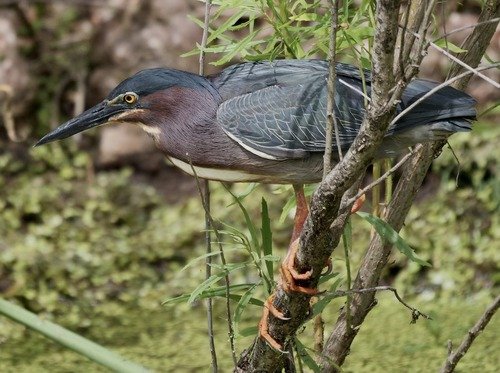Here’s the Central Texas bird forecast for the month, courtesy of Travis Audubon. Learn more about Central Texas birds and bird-related events for all ages at Travis Audubon or by calling 512-300-BIRD.
AUSTIN (KXAN) — If you want to beat the heat and see some birds without too much effort, one smart move is to visit a natural or manmade pond in the early morning or evening. Depending on the pond depth, acreage and amount of vegetation available, you can see a variety of species enjoying the water. Swallows come in to drink on the wing, herons and egrets search for small fish, and noisy Great-tailed Grackles and Red-winged Blackbirds raise their young in the bulrushes and cattails.
COURTESY: Jeff Osborne
Everyone is probably familiar with white egrets of various species, which stand out as they wade in the water hunting. No camouflage for them! To see a different species, be alert for one that blends in with the scenery. The Green Heron is our smallest heron at 18 inches, and it generally hugs pond and creek edges where it can be overlooked as it watches for prey. Unlike the most common white egrets, which look slender, long-necked and long-legged, the Green Heron is stocky and compact. It often has its neck drawn in, and it has short legs. It’s dark with a greenish back and crown that do not appear green except in good light, and the adult has a beautiful rufous neck and upper breast. It has a substantial pointed bill like other herons and egrets. One notable characteristic of the adult Green Heron is its bright orange legs when it is in peak breeding plumage. Juvenile birds, born this year, have streaked necks and white outlines to the wing feathers, and first summer birds have more chestnut in their necks but retain some throat streaking. Both young birds have greenish-yellow legs. One clue to a Green Heron’s presence is a loud “SKEEW” call when flying, usually after being flushed.

COURTESY: Jeff Osborne

COURTESY: Jeff Osborne
The Green Heron is one of the few birds that are considered tool users, a rare behavior in other herons. Watch closely, and you might see one fishing by breaking a twig and tossing a piece into the water to lure a fish to the surface. In the literature, one Green Heron was observed digging up earthworms to use as bait. Mayflies and other insects, bread crusts, leaves and berries have also been used. Green Herons appear to exhibit this behavior when the water is deeper, and the heron has a perch above it. To catch the prey, it extends its neck a surprising distance, quick as a flash. If you are extremely lucky, you might see a Green Heron dive into the water while fishing, completely submerging, and then swimming to shore. It will also dive feet first.

COURTESY: Jane Tillman
While the Green Heron generally stays in the shadows, it will hunt in the open, where it walks agonizingly slowly, keeping its body horizontal and head and neck retracted, looking at the water. It has been known to keep one foot in the air for 30 seconds before putting it down as it moves. It prefers water about 4 inches in depth or less due to its short legs. Green Herons are active at all hours of the day and night.

COURTESY: Jane Tillman
Green Herons are known breeders all over town. Try Mills Pond in north Austin, Bull Creek District Park by Loop 360, along Lady Bird Lake, the pond in Mueller at SE Greenway or Beverly S. Sheffield Northwest District Park along the creek or at the island in the pond. Even though the birds can be elusive, patience often rewards a photographer with great shots.
Green Herons typically nest in trees and shrubs close to or over water from ground level to 30 feet up, but up to a ½ mile away if there is water close by for foraging. The male starts building a nest before attracting a mate, but she finishes the shaping of the nest while he gathers sticks. Eggs are pale green. A pair stays together for the breeding season, taking turns incubating and tending the nest.

COURTESY: Jane Tillman
Green Herons have a large summer range in the eastern and central U.S. In winter, most migrate to central Mexico, Central America and even into northern South America. There are year-round populations in California, Florida and south of the border. Occasionally, one or two winter in Austin.

COURTESY: Jane Tillman
Fun Facts
Mated Green Herons are aggressive to grackles, which are known nest predators. A male Great-tailed Grackle is about the same length and weight as a Green Heron, but the Green Heron’s bill is a formidable weapon.
Biologists have studied the feeding behaviors of diurnal herons in North America. The Green Heron has 15 of the expected feeding behaviors, tying with the Great Blue Heron for the fewest out of 36 identified. According to Birds of the World, the feeding behaviors they exhibit are “Standing, Baiting, Standing Flycatching, Head Swaying, Neck Swaying, Walking Slowly, Walking Quickly, Scanning, Feetfirst Diving, Foot Stirring, Foot Raking, Plunging, Diving, Jumping, and Swimming Feeding.” Most are self-explanatory. Foot raking occurs when a heron scrapes up sediment to flush prey items. Foot stirring is somewhat like a baiting strategy, when the bird wiggles its foot tantalizingly to lure fish to the surface.
Upcoming Travis Audubon Events – Warm weather may dampen your enthusiasm for the great outdoors, so let Travis Audubon help. Check the events calendar for field trips and classes. New to birding? Try a beginner’s bird walk, such as the ones frequently offered at Commons Ford Ranch Metro Park. Events fill quickly, and registration is required for most.
Compiled by Jane Tillman, Travis Audubon Volunteer
Resources: All About Birds, Birds of the World, and The Sibley Guide to Birds by David Sibley.
